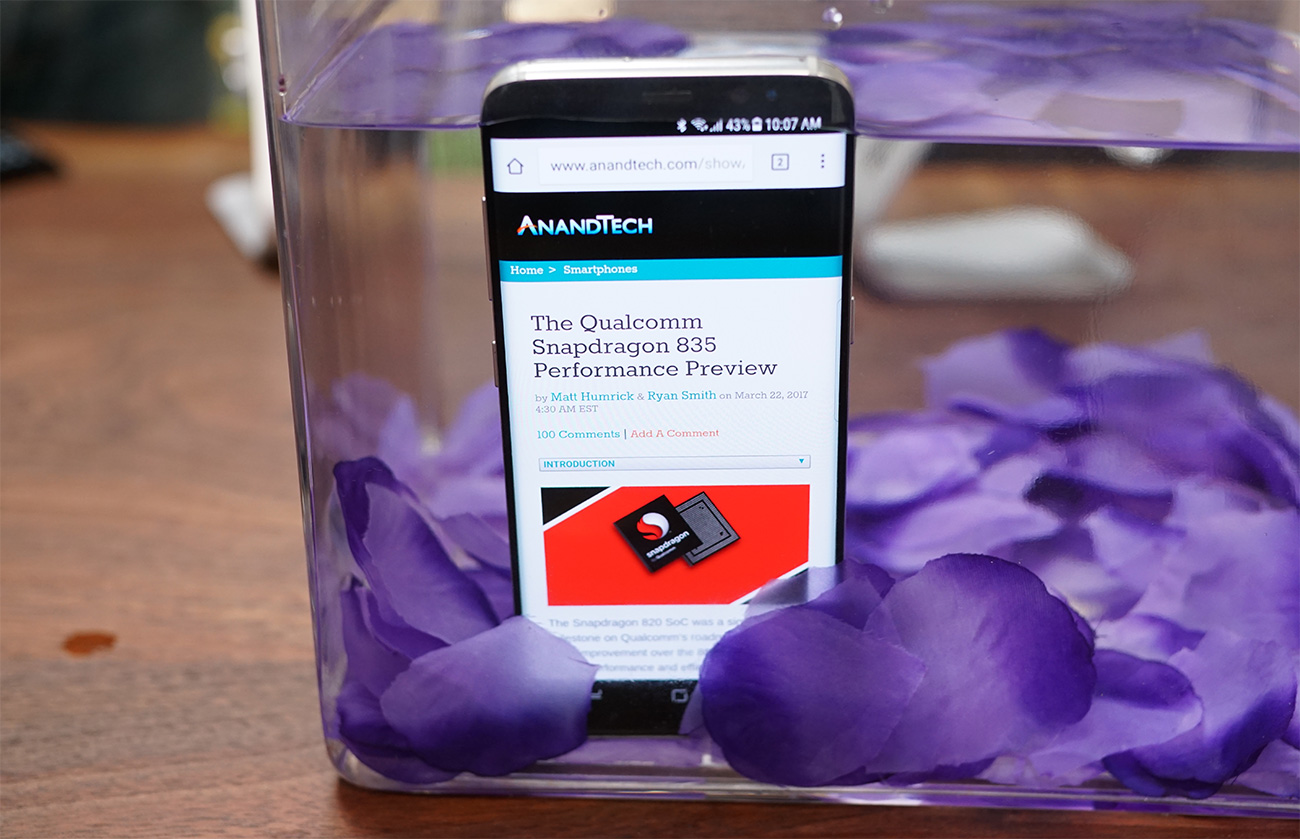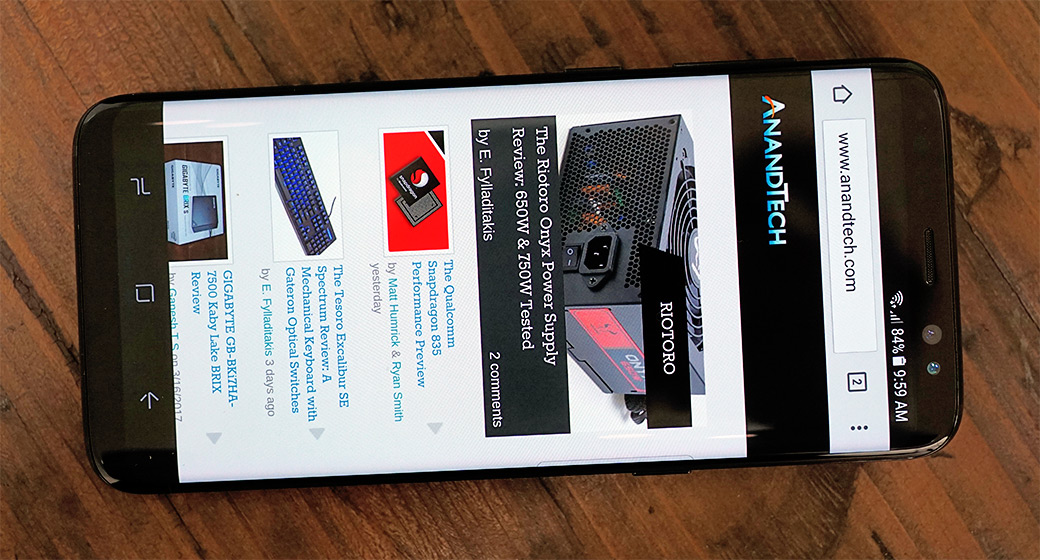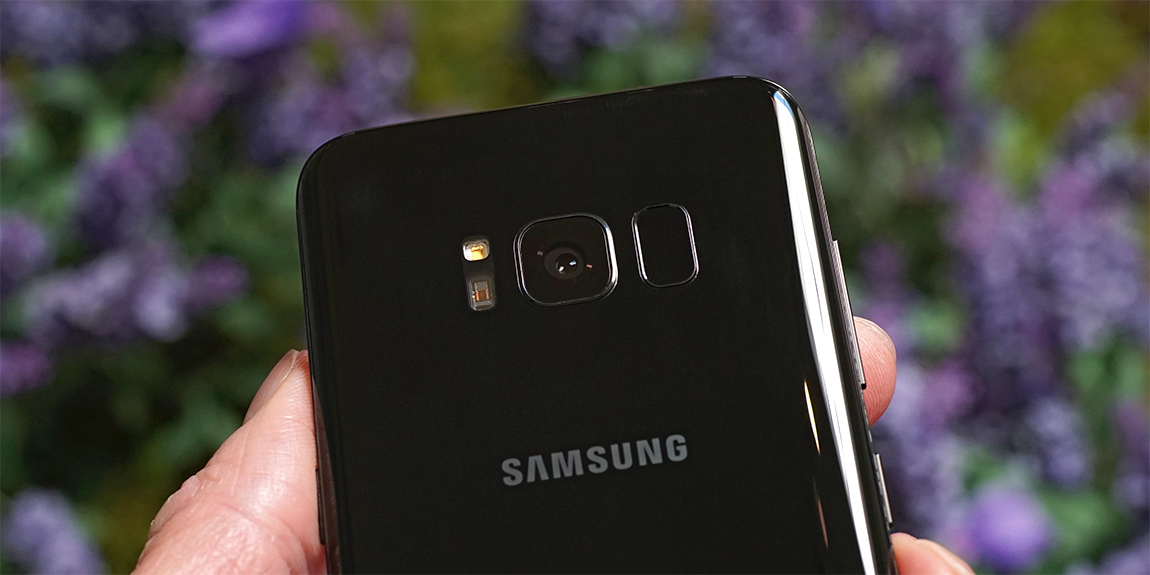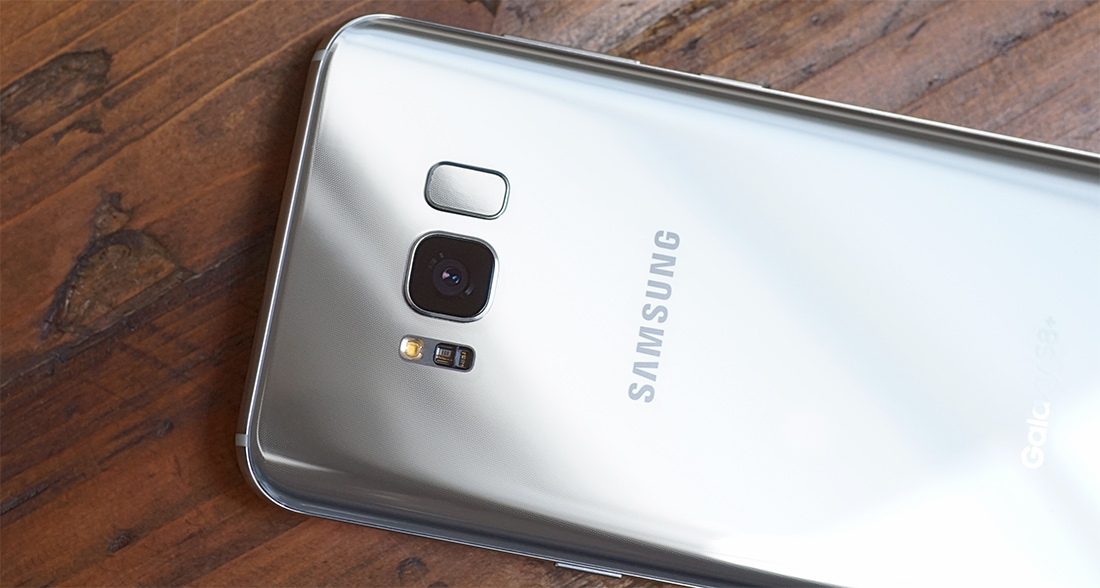Hands On With Samsung's Galaxy S8 and S8+: Taller Screens and Slimmer Bezels
by Matt Humrick on March 29, 2017 11:00 AM EST- Posted in
- Smartphones
- Samsung
- Galaxy
- Mobile
- Galaxy S8
Internal Hardware and Features
Inside the redesigned Galaxy S8 and S8+ is either a Qualcomm Snapdragon 835 or Samsung Exynos 8895 SoC. The US and other regions that require CDMA capability will get the Snapdragon 835. We already have some idea of what to expect from the 4x4 big.LITTLE Kryo 280 CPU and upgraded Adreno 540 GPU after some preliminary performance testing. We know less about the Exynos 8895, which the rest of the world will receive. When we spoke with Samsung LSI at MWC 2017, a representative told us that while the 8895 comes with a Mali-G71MP20 GPU, the GPU configuration and operating points are set by the OEM, meaning it’s possible the S8 will not use all 20 GPU cores.
| Samsung Galaxy S8 Series | ||
| Samsung Galaxy S8 | Samsung Galaxy S8+ | |
| SoC | Qualcomm Snapdragon 835 (US, China, Japan) 4x Kryo 280 Performance @ 2.35GHz 4x Kryo 280 Efficiency @ 1.90GHz Adreno 540 Samsung Exynos 8895 (rest of world) 4x Exynos M2 @ 2.30GHz 4x Cortex-A53 @ 1.70GHz ARM Mali-G71 |
|
| Display | 5.8-inch 2960x1440 (18.5:9) SAMOLED (curved edges) |
6.2-inch 2960x1440 (18.5:9) SAMOLED (curved edges) |
| Dimensions | 148.9 x 68.1 x 8.0 mm 155 grams |
159.5 x 73.4 x 8.1 mm 173 grams |
| RAM | 4GB LPDDR4 (US) | |
| NAND | 64GB (UFS 2.1) + microSD |
|
| Battery | 3000 mAh non-replaceable |
3500 mAh non-replaceable |
| Front Camera | 8MP, f/1.7, Contrast AF | |
| Rear Camera | 12MP, 1.4µm pixels, f/1.7, dual-pixel PDAF, OIS, auto HDR, LED flash | |
| Modem | Snapdragon X16 LTE (Integrated) 2G / 3G / 4G LTE (Category 16/13) Samsung LTE (Integrated) 2G / 3G / 4G LTE (Category 16/13) |
|
| SIM Size | NanoSIM | |
| Wireless | 802.11a/b/g/n/ac 2x2 MU-MIMO, BT 5.0 LE, NFC, GPS/Glonass/Galileo/BDS | |
| Connectivity | USB Type-C, 3.5mm headset | |
| Features | fingerprint sensor, heart-rate sensor, iris scanner, face unlock, fast charging (Qualcomm QC 2.0 or Adaptive Fast Charging), wireless charging (WPC & PMA), IP68, Mobile HDR Premium | |
| Launch OS | Android 7.0 with TouchWiz | |
The new SoCs are paired with 4GB of LPDDR4 RAM, the same amount that’s in the Galaxy S7, S7 edge, and most other flagship phones. Internal storage is limited to 64GB with the option to add additional capacity via microSD card. While this will be enough to satisfy most people, it would be nice to see a 128GB option for a flagship in this price bracket.
Even though overall size and thickness have increased slightly compared to the previous generation, battery capacity has not improved. The Galaxy S8 comes with a 3000mAh battery, the same size as the Galaxy S7, while the S8+ comes with a 3500mAh battery, slightly less than the S7 edge’s 3600mAh capacity. It will be interesting to see how battery life compares, considering the S8s’ larger screens contain nearly 16% more pixels, increasing power consumption if not offset by panel efficiency improvements or power savings elsewhere, such as the new 10nm SoCs. Regardless, it’s disappointing that Samsung is still prioritizing thickness over battery life.
The overall camera experience has been a differentiating feature for the past couple of Galaxy generations. Samsung gave the S7 and S7 edge a new 12MP rear camera last year that improved low-light image quality. It was also the first phone camera to use dual-pixel PDAF, which vastly improves autofocus performance by using every pixel for phase detection instead of just a handful of phase detection pixels scattered across the sensor.
While most flagships—and even some mid-range phones—are moving to dual-cameras and adding hybrid AF systems to improve performance and attract consumers’ attention, Samsung is content to reuse the S7’s rear camera for the S8 and S8+ but with updated image processing software. We’ve grown accustomed to seeing a new camera every year, but the S7’s (and now S8’s) camera is still among the best available for phones. Its combination of features (object-tracking AF, auto HDR, HDR live preview, manual mode, 2160p30/1080p60 video), quick performance (camera launch, image capture, AF, HDR processing), and excellent image quality add up to a great overall camera experience. Adding a second sensor could enable additional features, such as depth sensing for bokeh effects, or further improve image quality, but Samsung is either not willing or ready to travel that path yet.
The S8 and S8+ do get a new front-facing camera, however. The higher-resolution 8MP sensor is paired with a fast f/1.7 lens that’s capable of shooting up to QHD (2560x1440) video, although HDR, EIS, and video effects are deactivated in this mode. Samsung’s Smart AF feature uses face detection and contrast-based AF to improve image focus for selfies.

The Galaxy S8 and S8+ have an IP68 rating for water and dust resistance, so you can read AnandTech in the bath.
The new Galaxy phones come with Android 7.0 and Google Assistant. TouchWiz gets a facelift with more rounded corners to match the screen, but the most interesting new software feature is Bixby, Samsung’s new virtual assistant. This “intelligent user interface” promises expanded voice navigation, allowing you to (eventually) substitute voice commands for any touch-based actions. It’s deeply integrated into the OS already, and Samsung has an SDK available for third-party developers.
There’s more to Bixby then just telling your phone to adjust the screen brightness or open an app, however. Tapping the Bixby button in Samsung’s Camera app activates Bixby’s object recognition capabilities, allowing it to scan QR codes, process business cards, perform language translation, and provide product information and shopping links. It also learns your habits over time and provides context relevant information, reminders, and suggestions. For example, if you call your significant other on your drive home every day, Bixby will recognize this and offer to automatically dial his/her number for you. Bixby is still a work in progress, though, and it’s not clear how many of its features will be functional when the phones begin shipping.
Samsung is also announcing some new accessories alongside the Galaxy S8 phones. There’s a new version of Gear VR that’s compatible with the S8, S7, S6, and Note5 families. First announced at MWC 2017, this new model comes bundled with a touchpad controller that also enables hand tracking. Samsung’s Gear 360 VR camera also gets a refresh. It’s now capable of recording 4096x2048 H.265 video at 24fps, a slight increase over the previous version’s 3840x1920 resolution at 30fps.
Samsung's DeX docking station is a productivity-focused accessory that allows a Galaxy S8 phone to drive a desktop experience. The puck-shaped cradle includes an HDMI port, two USB 2.0 ports, and a 100Mbit/s Ethernet port for connecting the phone to an external monitor, keyboard, mouse, and wired network. The phone’s external speaker provides sound.
Instead of a stretched-out phone UI, the S8 provides a desktop environment with support for multiple, resizable windows, copy and paste between windows, and an app drawer for accessing all the Android apps installed on the phone.
The Galaxy S8 and S8+ will be available in US stores beginning April 21 and will come with Harman AKG earbuds. Pre-orders will begin at 12am ET on March 30. As an additional incentive, customers who pre-order the S8 or S8+ will receive a Gear VR with Controller for free. There’s also a premium bundle that throws in a 256GB microSD card and AKG Bluetooth headphones for an additional $99. Colors for the US include Midnight Black, Orchid Gray, and Arctic Silver. Coral Blue and Maple Gold colors will also be available in select markets. In the US, the Galaxy S8 will retail for $750, while the S8+ will cost $850.
The new Samsung Gear VR with Controller will also be available on April 21 for $129.99. The Controller can be purchased separately for $39.99.













208 Comments
View All Comments
WinterCharm - Wednesday, March 29, 2017 - link
Symmetry is good. Quit being a samsung fanboy.close - Wednesday, March 29, 2017 - link
You're talking about looks. Which are inherently subjective. How many times did you feel the need to ask anybody else what looks good?ddriver - Wednesday, March 29, 2017 - link
It might appear that it is subjective, but only to those, unaware of the roots of the human notion of engineering aesthetics.We humans don't really invent a lot, what we do most of the time is copy. We copy what nature has already done. Most of what nature does is symmetrical, with very few exceptions. And there is a good, functional reason for it. And as a result, most of what we do is symmetrical too - cars, planes, ships, guns...
We mostly break symmetry for ergonomics, but that means while a product gets optimized for a right-handed person, that makes it intrinsically a poor experience in the hands of a lefty. And vice versa.
This would be the case of this product too, while decent for a right handed person, the sensor placing is just too awkward for a left handed person, and even if those represent a mere 10% of the population, in that particular case it would have been very easy to have the best of both worlds by placing the sensor under the camera and moving the camera up a couple of notches.
Funny how superficial and silly some people are, immediately assuming I was taking exclusively about looks. And kind of paradoxical, since they only do that because they themselves only care about the looks, while at the same time not having the standards to judge looks aesthetics.
And yes, it would have also looked better, on top of being more practical, had the design been more symmetrical. It is important to also note the difference between "good design" and "pretty design" - good design is intrinsically practical, if it is not practical, then it is bad design, even if it is pretty. Good - bad, ugly - pretty. A design can be good even if ugly, or bad even if pretty, naturally, it is always best if you can have it both good and pretty, which this product could have easily been, but alas.
That's the problem with the industry, they have it cozy and easy because people are for most parts dumb, so rather than having consumers know and dictate then industry what they need and want, the industry would convince people what they want and have a blast selling them what can easily qualify for useless garbage relative to the full extent of the technological potential. They know they can get away with making products that are a fraction of the functionality, versatility, durability and value they can be, because that is in their best interest, which is making as much money as possible, which involves giving as little as possible to consumers while taking as much as possible from them. Which is how we get to have products with such blatantly obvious shortcomings. And the sensor position is just the tip of a very big iceberg. Luckily, most people don't know what they are missing, they go with the flow and do not complain, because they have no clue how much better, more useful and beneficial technology could be. So rather than having the optimal, we get barely incremental stuff, propped up by hype and useless gimmicks, where consumer use is just a screen to cover up the fact that this product is only 10% about the consumer using it, and 90% about the consumer being used through it. Hence we have powerful hardware that could have been extremely useful, yet is limited to a limited use toy, a money milking machine and a spyware / privacy invasion platform.
Reflex - Wednesday, March 29, 2017 - link
"So rather than having the optimal"This amused me. As an engineer in the hardware and software industry, what is 'optimal' varies user to user. There is no such thing as universally optimal anything. There is this notion that products are developed sub-optimally for the lowest common denominator, but in truth that is not the case. Products are differentiated from each other to capture what is the closest to optimal for a subset of the potential customer base. Just because something is sub-optimal to one person does not make it less than optimal or close to optimal for another. There is a reason Samsung releases 3-5 variants of every major iteration of their product lines.
I can argue with my brother all day that my Sennheiser's are better than his Beats headphones by any objective analysis. I can argue that they are optimal for anyone who values quality sound at several given price points. But that is only because what is optimal for me is not optimal for him. He values appearance, style and social cache. I do not share those metrics as important. That does not mean my metrics are any more or less valuable than his. After all, as he would remind me, his hearing was damaged significantly during the Iraq war, he is unable to really discern the level of detail I can and all of the additional clarity I get from my Senns is wasted on him. At a given price point, why wouldn't he get the set of cans he finds more attractive?
Optimal is in the eyes (and requirements) of the beholder.
Meteor2 - Thursday, March 30, 2017 - link
Reflex, that's a really insightful comment. Thank you.lilmoe - Thursday, March 30, 2017 - link
+1It gets tiring arguing with people about what's optimal.
ddriver - Thursday, March 30, 2017 - link
Just because you cannot abstract from your subjectivity doesn't mean objectivity is unattainable to anyone.The opinion of the ignorant generally doesn't matter. People are often dumb enough to convince them into believing the most preposterous stuff. A rapist probably believes that raping people is a good thing too, but that doesn't make it so by any measure, regardless of his personal beliefs.
Arguing is pointless, I do not argue, I just tell how things are. If you want to argue, knock yourself out. My opinions are very well substantiated by fact, logic and reason, and back in the days when I still used to argue, I found out that people I argued with couldn't really make a substantiated argument, because the opinions they advocate aren't the product of logic and reason to begin with.
Imagine a car, but not just a car you could drive anywhere there is road with, but a car you whose software only allows you to drive it to very specific places, not that much where you want to go, but where someone else wants you to.
That's the kind of limitations and deviations from the "optimal" I talk about. Because today phones are just as capable as the general purpose computers of 10 years ago, yet none of that functionality is available, which is not optimal. Not only that, we are seeing general purpose computers going the same way too, turning more and more into walled gardens, before long it may be considered a criminal offense to even own a general purpose computer that you can do whatever you want with, rather than only what say M$ wants you to.
This is not optimal. And I don't mean subjectively, but objectively, granted, corporations would be very happy about that, so you could say it would be subjectively optional for them to further reduce the value of their products and increase their control. But I didn't talk about "subjective" to begin with, you understood it as such because evidently you haven't reached the milestone that is discovery of the objective and absolute. But you will not find it until you manage to outgrow yourself.
ddriver - Thursday, March 30, 2017 - link
Also, claiming to be an engineer, and then claiming that Li-Po batteries regrade less than Li-Ion is kinda contradictory. I'd expect an actual engineer to be aware that the two technologies are very much identical in terms of cell durability, rather than to throw around urban legends how Li-Po "solved" degradation.Retycint - Thursday, March 30, 2017 - link
>"A rapist probably believes that raping people is a good thing too">"My opinions are very well substantiated by fact, logic and reason"
Are you even listening to yourself
Meteor2 - Thursday, March 30, 2017 - link
To be honest I'm concerned about ddriver's mental health, but this isn't the place to discuss it or do anything about it.